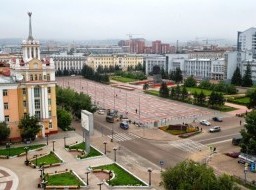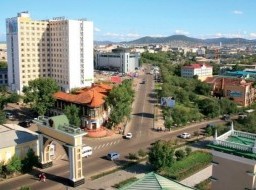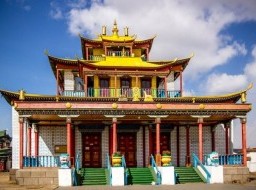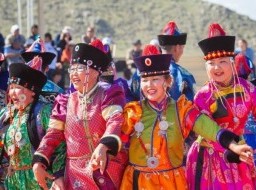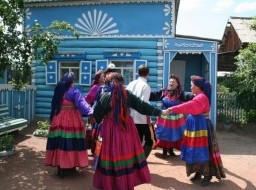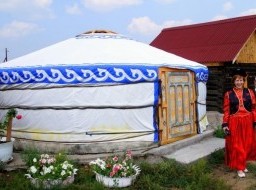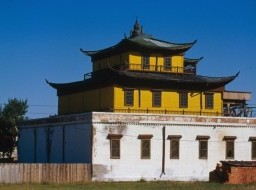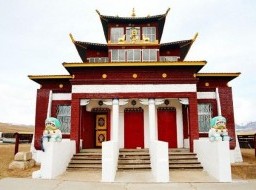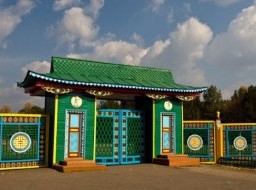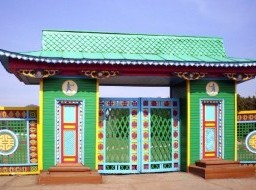Lenin Street (Arbat)
Lenin Street is the central street of the city of Ulan-Ude. Initially, Traktovaya street, named after the Siberian route passing along it. It was built from the Odigitrievsky Cathedral, erected in 1741 to the Upland Square. Later - Bolshaya Street, after the visit of Tsarevich Nicholas Alexandrovich (June 20-21, 1891) - Bolshaya Nikolayevskaya street. Since 1924, bears the name of Lenin. The length is 1550 m. It goes from the south to the north from the Quay of the street to the Sukhbaatar street. The numbering of houses from the Quay, where in the lower part, the fence of the Odigitrievsky Cathedral bends from the west; further intersected by the streets of Banzarova, Sverdlov, Kuibyshev; in the middle part passes along the western edge of the Revolution Square; above is a 360-meter stretch from Kirov Street to Sovetskaya Street, which is a pedestrian zone (the so-called Ulan-Ude Arbat), there is a non-intersecting intersection with Kalandarishvili Street; at the theater of opera and ballet in front of the Arch from Lenin Street to the southeast the Pochtamtskaya street leaves and to the east a short dead-end street of Nekrasov. In the upland part, Lenin Street passes along the eastern edge of the Theater Square, from where the Erbanova Street goes east, and then goes along the western edge of Soviets Square. At the corner of Lenin and Sukhbaatar streets near the building of Ulan-Ude General Post Office (61 Lenina Street) there is an index of the Zero kilometer of Buryatia. In 1791 in the middle of the tract road on the east side was built a wooden building of the Gostiny Dvor. September 6, 1830 through Verkhneudinsk Petrovsky plant was the first batch of exiled Decembrists. The second party passed through the city on September 8. Baron VI Shteingel wrote in his diary about the transition through Verkhneudinsk: They rose early. The convoy in the parade. Before the city we were met by the police. The people crowded in heaps along the hills. On faces - one silly curiosity. The commandant was at the bridge across the river. Udu. On the other side of the river, in the first house on the left hand, several ladies and Verdudin dandies watched from the gallery. June 20-21, 1891 through Verkhneudinsk passed the prince Nikolai Alexandrovich. On this occasion, at the exit from Nagornaya Square to Bolshaya ulitsa, a wooden arch was constructed according to the project of NA Pauva, with the inscription "To His Imperial Highness the Tsar Naslednik Tsarevich Nikolai Aleksandrovich", and on the other hand the date of the visit "20-21 June 1891, Verkhneudinsk "(the arch was demolished in 1936, it was rebuilt in 2006). In 1908, the construction of wooden houses was prohibited on the street. In March of this year in the house of NL Kapelman the merchant's son Yakov Yevseyevich Tsigalnitsky opened the first confectionery and coffee shop in the city. For a long time they remained the only ones in Verkhneudinsk. The Soviet periodIn the early 1920s, the Revolutionary Committee (Burrevkom) and two judicial sections were located in the house of Kobylkin (Lenin street, 27). November 23, 1923 in the house of Burkoopsoyuz (Kapelman's house) began to work Verkhneudinsk commodity exchange. On May 6, 1924, by Decree No. 33, the City Executive Committee ordered owners and tenants of houses to plant trees near their houses along the streets of Lenin, Young Communard, Mongolian, Communal and Militia. In July this year, the magazine "Life of Buryatia", whose editorial office was located at No. 73, was published. February 20, 1925 in the house number 11 opened the Central Regional Library. July 22, 1926 Russian society of voluntary air fleet "Dobrolot" began a regular communication on the route Verkhneudinsk - Urga. Management of the air line was located at: ul. Lenin, 26. In 1928, on the street, individual scenes of the feature film "The Descendant of Genghis Khan" were shot. In 1936, a lot of sculptures of Lenin were brought to the city. Near almost every school stood the sculpture of Ilyich, on Lenin Street there were three of them. The first Lenin stood near the Hodegetria Cathedral. The second monument was on the Revolution Square and the third one at the post office ...- Memoirs of the regional specialist RA Serebryakova // Ulan-Ude: history and modernity. Ulan-Ude, 2001.In 1936, Lenin Street began to give performances Orgtheater (the building of the theater was not preserved). November 17 this year, the House of Pioneers was opened. In 1938 the construction of a water pipe began along the streets of Smolin, Sverdlov and Lenin, where the House of Pioneers was connected to the network. In 1939, Lenin Street was covered with asphalt. In the autumn the House of Specialists was built (Lenin street, 33). In 1952, the construction of the building of the Buryat Opera and Ballet Theater (Lenina Street, 51) was completed according to the project of architect A. Fyodorov. Above the central portal was installed a sculptural group "Horsemen" with an unfurled banner. Sculptor - AI Timin. On May 1, the grand opening of the theater took place, and on November 7 - the premiere of the first performance. On July 18, 1960, the Buryat Geological Administration opened the Geological Museum (57 Lenina Street). In 1967 the puppet theater "Ulger" was founded (Lenin street, 46). In 1968, the Central City Library was opened (Lenina Street, 17). July 12, 1983 the Museum of Nature of Buryatia (46 Lenina Street) began to work. |

